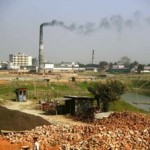Last fall, residents of Agadez, Niger, awoke to a loud noise. Rains, unusual at any time, but especially during the dry season, had fallen on the mountains to the north. The water moved south, rolling over the sand unchecked. In farming villages, gardens of tomatoes, cabbages, peppers, and maize were quickly submerged. Mud brick houses were destroyed and livestock washed away.
Malassane Boungoudou dealt with the sudden deluge by stacking three beds on top of each other and perching her children on top. When the walls of the house started to crumble, she got out. Following the flood, she and her family spent two months in a relative’s garage, afraid to return.
The World Bank-financed Community Action Program (CAP), already working in Agadez, provided immediate assistance to villagers. Commune leaders came together to evaluate immediate needs, and with the help of the CAP, secured pumps, cattle, seeds and fertilizer, as well as tools.
Residents contributed to the project by providing in-kind labor to replant crops and vegetables, construct an irrigation system, reinforce dikes, and build new fencing. With renewed access to irrigation, women were able to start community gardens for staple crops, which they share and use to feed their families.

In addition, a women’s self-help group called Alhéri Mai Yawa is using revolving funds to recover assets lost in the disaster. The funds allow women to sell spices and take in sewing, securing a regular income for their families.
As one mayor said, “The program breathed new life into our community.”
Local Communities Decide Priorities
CAP, which began in 2003, improves the capacity of two-thirds of Niger’s local governments (communes) to design and implement development plans with small capital grants, thereby enhancing livelihoods, and “priming the pump” of decentralization.
Co-financed by Global Environment Facility (GEF) and the International Fund for Agricultural Development (IFAD), the program also reduces land degradation and promotes sustainable land management.
Program investments are guided by Communal Development Plans (CDPs), developed by communal councils, which include at least two women. The councils outline a framework of needs and priorities as expressed by villagers, as well as resources available from a variety of sources, including from the beneficiaries themselves through a financial contribution or, most often, in-kind labor.
“This is hard work, but people give freely of themselves because they know it’s for them,” said one mayor in Agadez.
In this locally owned process, villagers agree on a list of projects to be implemented with backstopping from local technical experts from decentralized offices of national ministries.
“The CAP works because it makes the most of local abilities and builds on the pride that people take in managing the development process by themselves,” said Daniel Sellen, World Bank Co-Task Manager for CAP, based in Abidjan, Ivory Coast.
“Communities themselves articulate their needs, they come up with solutions, they handle the money and procure the necessary services, and they implement the micro-projects. They’ve never done this before, but they are surprisingly good at it.”
Nigerien communities have funneled CAP resources to a wide range of projects. In the first phase, communities built 322 school classrooms for 15,000 students; 153 literacy centers for 6,000 adults; health posts to provide primary care to 300,000 people; and wells and boreholes to provide 170,000 people with access to clean drinking water.
Additionally, CAP financed more than 1,000 income-generating micro-projects in agriculture, fisheries, and livestock, which benefited an estimated 100,000 people, 80% of whom were women.
Next Challenge: Fighting Drought
Through CAP, the Bank is also addressing climate risk issues in Niger. Despite the surprise flood that hit Agadez last year, rainfall across the Sahel is down and the Sahara is fast encroaching. There is perhaps no country in the world more at risk for desertification.

CAP benefits from GEF financing to reduce land degradation and promote sustainable land management. This has led to increased agricultural productivity, increased vegetative cover, increased carbon sequestration, and reduced sedimentation of watercourses. In the first phase, nearly 9,000 hectares of land were developed with sustainable land management technologies, thereby reducing water erosion in 88% of sites.
Niger is currently confronting another drought, with food insecurity rising to alarming levels. The 2009 agricultural season failed and created widespread cereal deficits, placing many households in dire circumstances.
As a result, communes approached CAP for assistance, requesting financing for cereal banks. CAP and the World Food Program (WFP) recently reached an accord to mobilize $1 million to establish 136 cereal banks in 48 communes. With the funding, the banks were able to acquire 1360 tons of millet and rice, construct storehouses, and train managers.
“The CAP was designed to stimulate local development, but as a decentralized project with a presence in about two-thirds of communities in Niger, we discovered we had a useful platform from which to quickly respond to emergencies,” says World Bank Co-Task Manager Amadou Alassane, based in Niamey, Niger.
“In fragile environments like Niger, and as we saw with the Agadez flooding, the priorities of the poor can change from day to day. This project has been able to quickly mobilize funds and technical assistance to address these priorities as they arise.”














